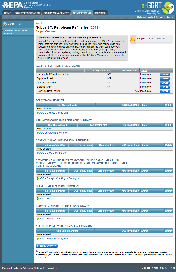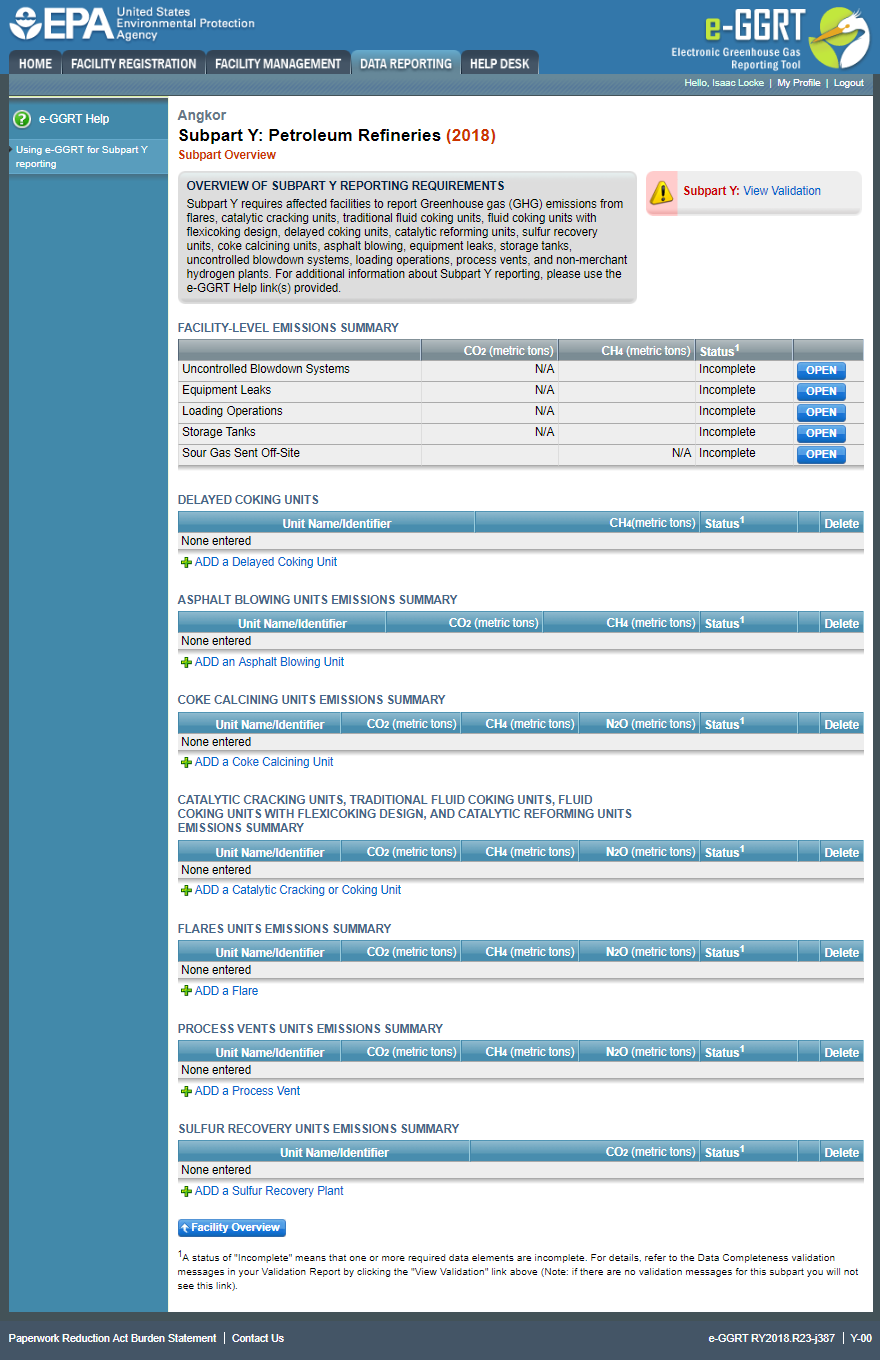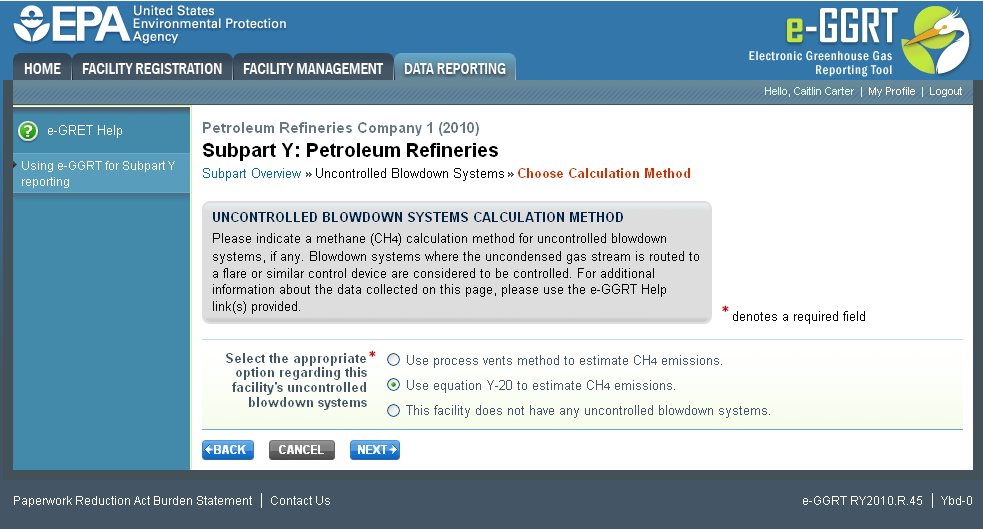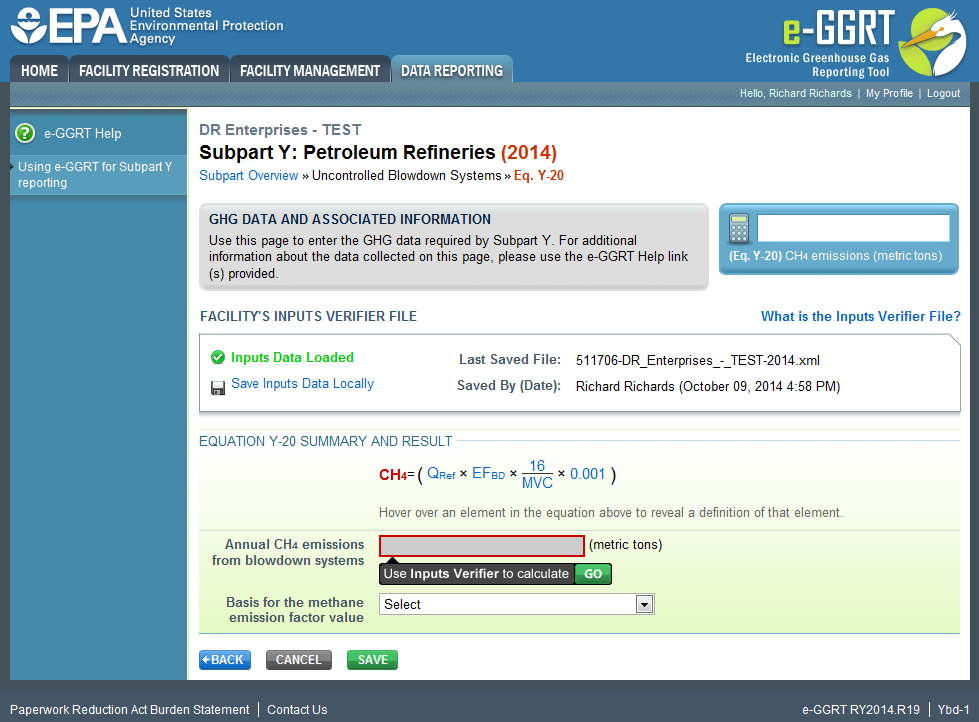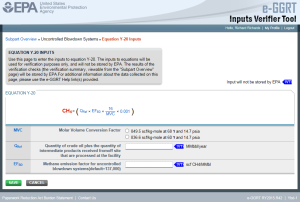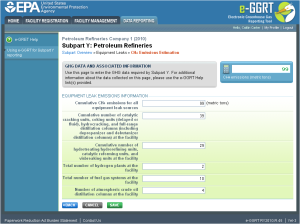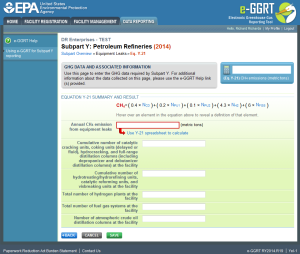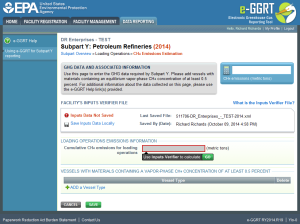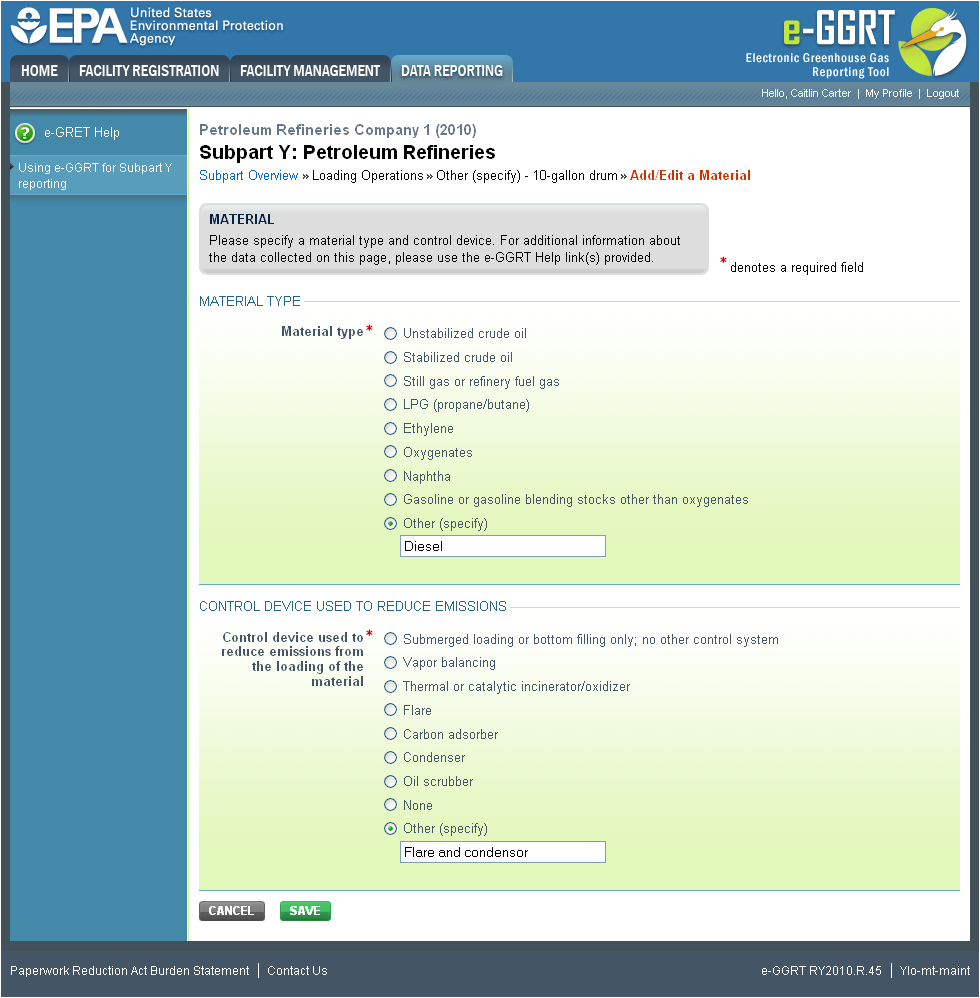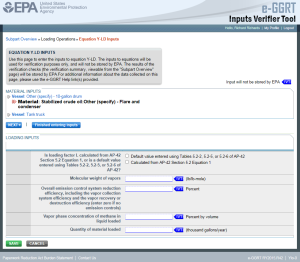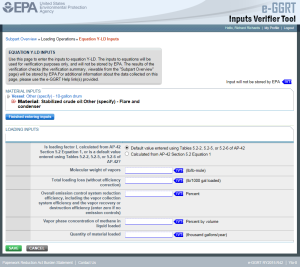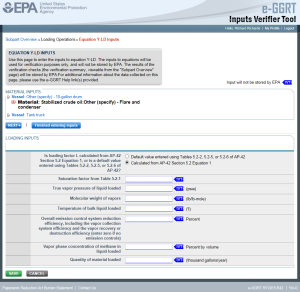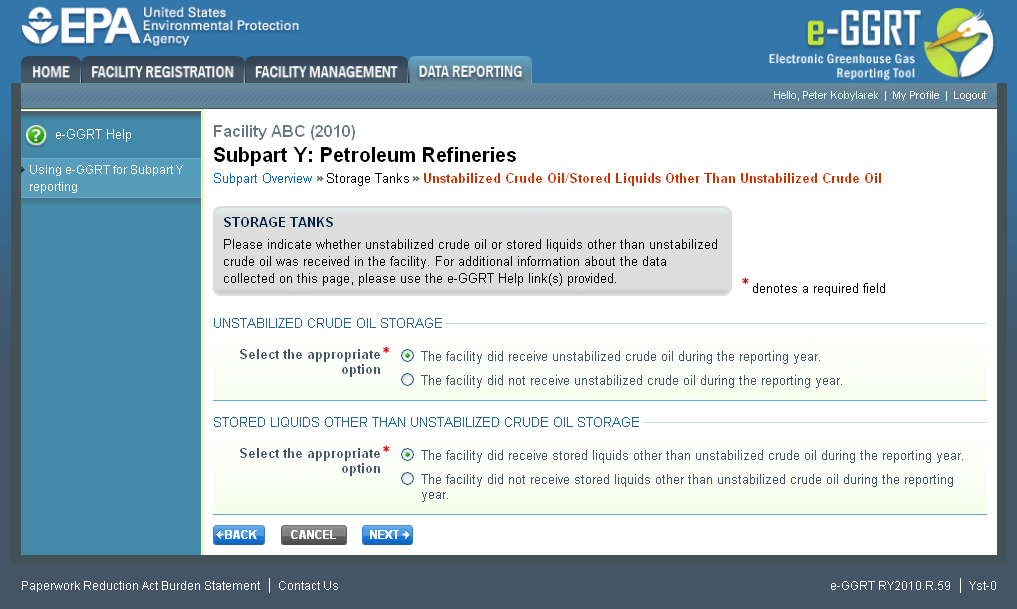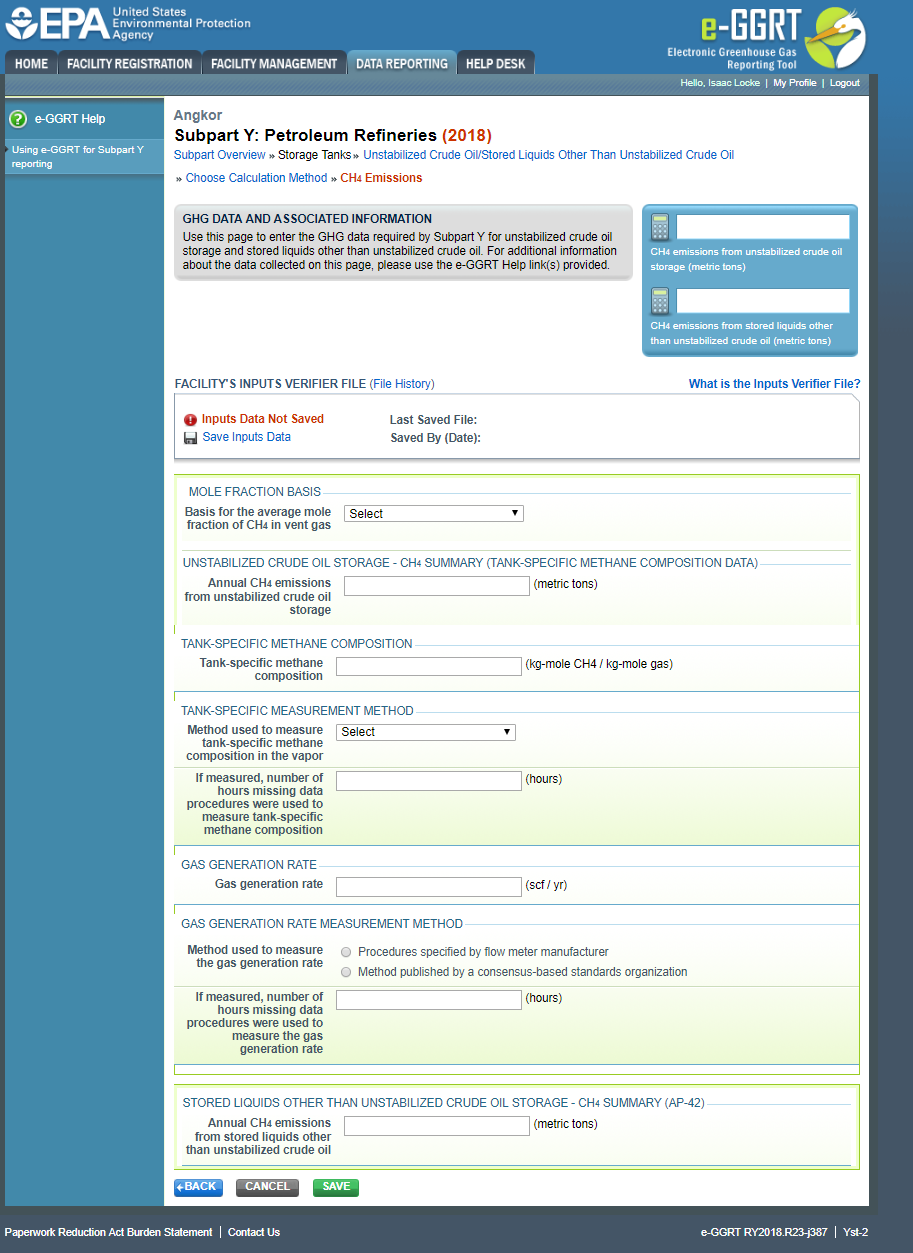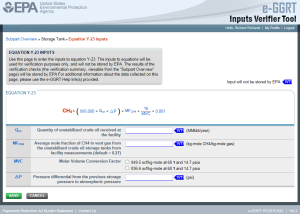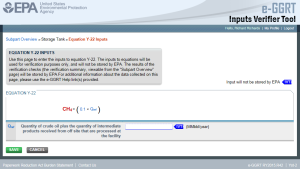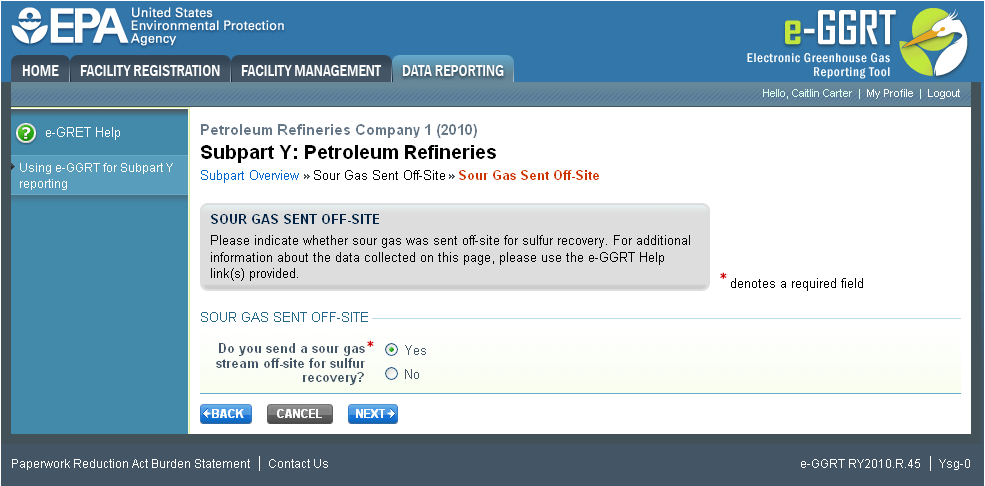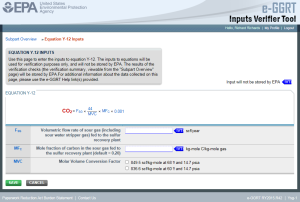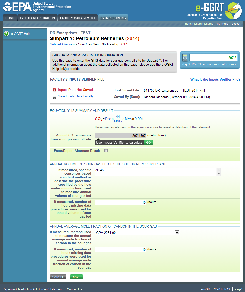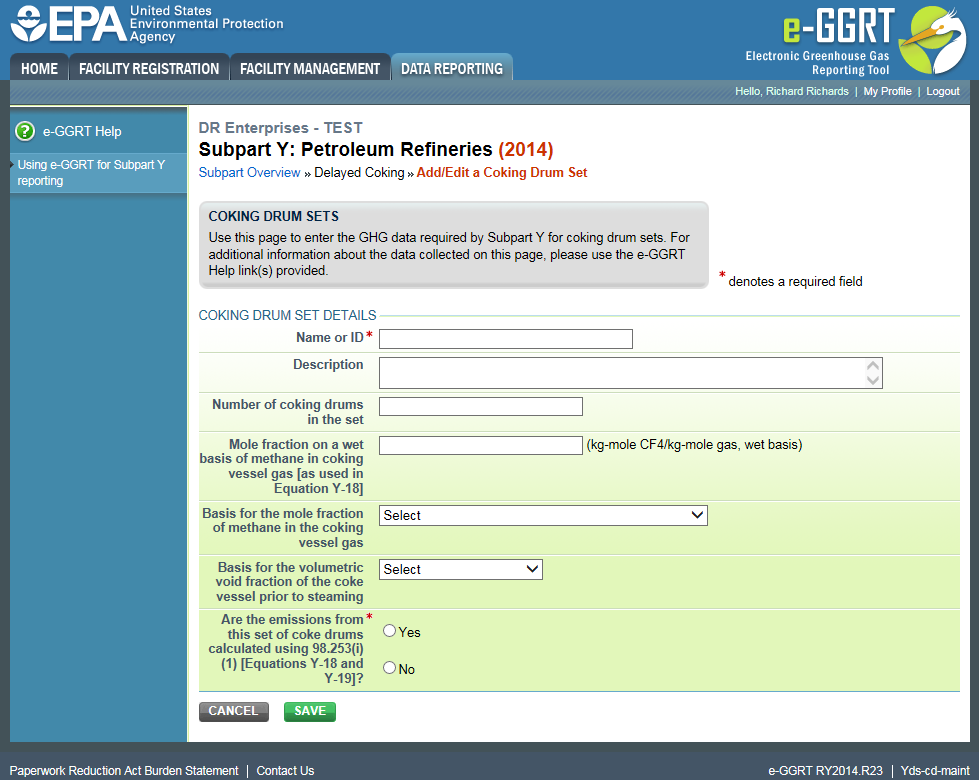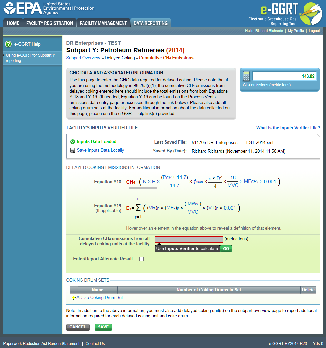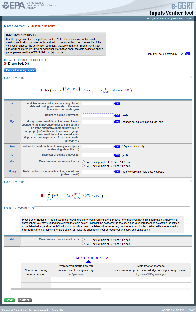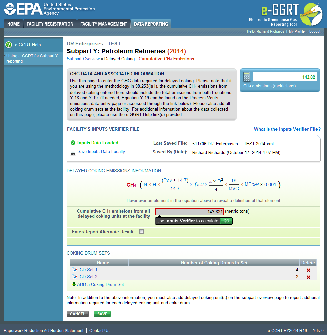This topic provides a step-by-step description of how to enter Subpart Y summary information about this facility.
Click this link to expand
Updating Summary Information for this Facility
To update Subpart Y Summary Information for this Facility, locate the FACILITY-LEVEL EMISSIONS SUMMARY table on the Subpart Y Overview page, and click OPEN for the appropriate section.Updating Uncontrolled Blowdown Systems
Petroleum Refineries must specify a CH4 calculation method for uncontrolled blowdown systems, if any. Blowdown systems where the uncondensed gas stream is routed to a flare or similar control device is considered to be controlled.
Click this link to expand
Step 1: Select Estimation Method
Subpart Y requires you to specify the appropriate option regarding this facility's uncontrolled blowdown systems. Select from:
- Use process vents method to estimate CH4 emissions
- Use equation Y-20 to estimate CH4 emissions
- This facility does not have any uncontrolled blowdown systems
When you are finished, click NEXT.
If “This facility does not have any uncontrolled blowdown systems” is selected then no further data is collected for uncontrolled blowdown systems.
Depending on which methodology you choose, follow either Step 2a or Step 2b.
Step 2a: Process Vent Method for Uncontrolled Blowdown Systems
The annual CH4 emissions from uncontrolled blowdown systems are a required data element . The e-GGRT system provides links to optional worksheets that may be used to perform the calculations; use of the spreadsheet is entirely optional and is provided for your assistance. To calculate this value using the optional spreadsheet, download the spreadsheet by clicking the link titled “Use Y-19 spreadsheet to calculate”. Fill in the spreadsheet using the instructions in the spreadsheet. After completing the spreadsheet, copy the value of CH4 calculated by the spreadsheet to this page in the box next to “Annual CH4 emissions from uncontrolled blowdown systems (metric tons)”.
The Equation Y-19 Summary is presented on the page. You can hover over an element in the equation to reveal a definition of that element.
Subpart Y collects the following data:
- Annual volumetric flow discharged to the atmosphere (scf)
- Method used to measure or estimate the annual volumetric flow rate:
- Continuous or at least hourly measurements
- Routine (less frequent than hourly but at least weekly) measurements
- Periodic (less frequent than weekly) measurements
- Process knowledge
- Engineering calculation
- Other (specify)
- Number of cumulative venting events for all relevant vents, if vent is intermittent (see note below)
- Cumulative venting time for all relevant vents (hours)
- Annual average mole fraction of CH4 (decimal between 0 and 1)
- Method used to measure or estimate the mole fraction of CH4:
- Engineering estimates/process knowledge
- Direct measurement
- Other (specify)
Note that number of venting events is not applicable for continuous venting in which case you may leave this field blank
Step 2b: Equation Y-20 Summary and Result
The annual CH4 emissions from uncontrolled blowdown systems are a required data element and are calculated by the Inputs Verification Tool (IVT) from the equation inputs you enter.
The Equation Y-20 Summary is presented on the page. You can hover over an element in the equation to reveal a definition of that element.
Click this link to expand
Before you can access the IVT module for Equation Y-20, you must select the basis for the methane emission factor value from the following options in the dropdown box labeled "" in the EQUATION Y-20 SUMMARY AND RESULT section of this page:
- Company records
- Measurement data
- Process Knowledge/Engineering calculation
- Used default emission factor
- Other (specify)
Also in the EQUATION Y-20 SUMMARY AND RESULT section, you will find a data entry cell labeled "Annual CH4 emissions from uncontrolled blowdown systems." Immediately below this data entry cell you will see a block labeled "Use Inputs Verifier to calculate" and a green "Go" box. To open the IVT module for Equation Y-20, you must click "Go." See Subpart Y Entering Equation Inputs Using IVT for instructions on using the IVT modules, including the important steps of loading and saving your inputs verifier file.
For uncontrolled blowdown systems emissions calculated using Equation Y-20, enter the following information in the IVT module (see the screen shot below):
- 836.6 scf/kg-mole at 60 °F and 14.7 psia
- 849.5 scf per kg-mole at 68 °F and 14.7 psia
- Methane emission factor for uncontrolled blown systems (default = 137,000) (scf CH4/MMbbl)
Click SAVE to return to the Equation Y-20 page for uncontrolled blowdown systems. The value calculated by the IVT module will be displayed in the "Annual CH4 emissions from uncontrolled blowdown systems" cell. Below this a checkbox labeled “Enter/Report Alternate Result" will be displayed. Checking this checkbox will cause a data entry cell labeled “Enter Own Result” to appear in which you may enter a value that you consider to be more accurate than the one calculated by the IVT module.
Step 3: Save Your Data
When you have finished entering uncontrolled blowdown data, click SAVE.
After you save the data on this page, the next time you open the page, the calculator on the top of the page will display the CH4 emissions, rounded to the nearest 0.01 of a metric ton. The value displayed is for informational purposes only.
Updating Equipment Leaks
Petroleum Refineries must specify the method used to calculate the reported CH4 equipment leak emissions.
Click this link to expand
Step 1: Select Estimation Method
Subpart Y requires you to specify the appropriate option regarding this facility's equipment leaks. Select from:
- Use process-specific methane composition data and any of the emission estimation procedures provided in the Protocol for Equipment Leak Emissions Estimates (EPA-453/R-95-017, NTIS PB96-175401)
- Use Equation Y-21
When you are finished, click NEXT.
Depending on which methodology you choose, follow either Step 2a or Step 2b.
Step 2a: Process-specific Methane Composition Data Method Summary and Result
If the “Use process-specific methane composition data and any of the emission estimation procedures provided in the Protocol for Equipment Leak Emissions Estimates” option was selected then the following screen will display.
Click this link to expand
Enter process-specific methane composition data (from measurement data or process knowledge) and any of the emission estimation procedures provided in the Protocol for Equipment Leak Emissions Estimates (EPA-453/R-95-017, NTIS PB96-175401).
Enter the following data:
- Cumulative CH4 emissions for all equipment leak sources (metric tons)
- Cumulative number of catalytic cracking units, coking units (delayed or fluid), hydrocracking, and full-range distillation columns (including depropanizer and debutanizer distillation columns) at the facility
- Cumulative number of hydrotreating/hydrorefining units, catalytic reforming units, and visbreaking units at the facility
- Total number of hydrogen plants at the facility
- Total number of fuel gas systems at the facility
- Number of atmospheric crude oil distillation columns at the facility
Step 2b: Equation Y-21 Summary and Result
If the “Use Equation Y-21” option was selected then the following screen will display.
Click this link to expand
The Equation Y-21 Summary is presented on the page. You can hover over an element in the equation to reveal a definition of that element.
The annual CH4 emissions from equipment leaks is a required data element. The e-GGRT system provides links to optional worksheets that may be used to perform the calculations; use of the spreadsheet is entirely optional and is provided for your assistance. To calculate this value using the optional spreadsheet, download the spreadsheet by clicking the link titled “Use Y-21 spreadsheet to calculate”. Fill in the spreadsheet using the instructions in the spreadsheet. After completing the spreadsheet, copy the value of CH4 calculated by the spreadsheet to this page in the box next to “Annual CH4 emissions from equipment leaks (metric tons).”
Also enter the following data:
- Cumulative CH4 emissions for all equipment leak sources (metric tons)
- Cumulative number of catalytic cracking units, coking units (delayed or fluid), hydrocracking, and full-range distillation columns (including depropanizer and debutanizer distillation columns) at the facility
- Cumulative number of hydrotreating/hydrorefining units, catalytic reforming units, and visbreaking units at the facility
- Total number of hydrogen plants at the facility
- Total number of fuel gas systems at the facility
- Number of atmospheric crude oil distillation columns at the facility
Step 3: Save Your Data
When you have finished entering the above data, click SAVE.
After you save the data on this page, the next time you open the page, the calculator on the top of the page will display the CH4 emissions, rounded to the nearest 0.01 of a metric ton. The value displayed is for informational purposes only.
Updating Loading Operations
Petroleum Refineries must specify the cumulative annual methane emissions (in metric tons of each pollutant emitted) for loading operations. Select OPEN under Loading Operations in the FACILITY-LEVEL EMISSIONS SUMMARY table on the Subpart Y Summary page. This action will open a page that poses the following question: "Do you perform loading operations for crude oil, intermediate, or product, for which the vapor-phase concentration of methane is 0.5 volume percent or more?" If you select "Yes" and click NEXT, you will be taken to the Loading Operations CH4 Emissions page. (Selecting "No" and clicking NEXT will return you to the Subpart Y Summary page.)
Click this link to expand
Before you can enter emissions information on Loading Operations CH4 Emissions page, you must first enter vessel types in the VESSELS WITH MATERIALS CONTAINING A VAPOR-PHASE CH4 CONCENTRATION OF AT LEAST 0.5 PERCENT section
Step 1: Vessels
Complete the applicable Vessels sections for vessels with materials containing a vapor-phase CH4 concentration of at least 0.5 percent.
Click the link titled "ADD a Vessel Type".
Click this link to expand
Specify the type of vessel:
- Ship or ocean-going vessel
- Railcar
- Tank truck
- Container
- Other (specify)
You may immediately enter materials containing a vapor-phase CH4 concentration of at least 0.5 percent for this vessel now or whenever you edit an existing vessel (see Step 2: Materials). When you are finished, click SAVE.
Continue to add vessels until all vessel types with materials containing a vapor-phase CH4 concentration of at least 0.5 percent are listed.
To edit an existing Vessel (e.g., to add, edit, or delete a material), click on the edit icon or the Name/ID link, which is the first column in the VESSELS SUMMARY table.
To delete an existing Vessel, click on the delete icon, which is the last column in the VESSELS SUMMARY table.
Step 2: Materials
Complete the applicable Materials section for each vessel.
Click the link titled "ADD a Material" while adding or editing a Vessel type.
Click this link to expand
Specify the type of material:
- Unstabilized crude oil
- Stabilized crude oil
- Still gas or refinery fuel gas
- LPG (propane/butane)
- Ethylene
- Oxygenates
- Naphtha
- Gasoline or gasoline blending stocks other than oxygenates
- Other (specify)
Specify the control device used to reduce emissions from the loading of the material:
- Submerged loading or bottom filling only; no other control system
- Vapor balancing
- Thermal or catalytic incinerator/oxidizer
- Flare
- Carbon adsorber
- Condenser
- Oil scrubber
- None
- Other (specify)
When you are finished, click SAVE.
Continue to add materials for a specific vessel type until all materials containing a vapor-phase CH4 concentration of at least 0.5 percent that are loaded in the specified vessel type are listed.
To edit an existing Material, click on the edit icon or the Name/ID link, which is the first column in the MATERIAL SUMMARY table.
To delete an existing Material, click on the delete icon, which is the last column in the MATERIAL SUMMARY table.
When you are finished, click SAVE.
Step 3: Loading Operations Emissions Information
Access the IVT module for calculating the cumulative CH4 emissions for loading operations, by clicking on the green GO button in the box labeled "Use Inputs Verifier to calculate" immediately below the CH4 emissions data cell on the Loading Operations CH4 Emissions page. (See Subpart Y Entering Equation Inputs Using IVT for instructions on using the IVT modules, including the important steps of loading and saving your inputs verifier file.)
The vessels you entered in Step 2 will be listed in the MATERIALS INPUTS section at the top of the page. The materials you entered for the first vessel listed will also be displayed and a red arrow to the left of the first material for that vessel indicates that data should be entered for that materials in the LOADING INPUTS section. You can use the PREV and NEXT buttons to navigate between the vessels and each of their materials.
Click this link to expand
Use the following radio buttons to identify the source of the loading factor L:
- Default value entered using Tables 5.2-2, 5.2-5, or 5.2-6 of AP-42
- Calculated from AP-42 Section 5.2 Equation 1
If you selected "Default value entered using Tables 5.2-2, 5.2-5, or 5.2-6 of AP-42", enter the following information in the IVT page (see screen shot below):
- Molecular weight of vapors (lb/lb-mole)
- Total loading loss (without efficiency correction) (lb/1000 gal loaded)
- Overall emission control system reduction efficiency, including the vapor collection system efficiency and the vapor recovery or destruction efficiency (enter zero if no emission controls) (Percent)
- Vapor phase concentration of methane in liquid loaded (Percent by volume)
Quantity of material loaded (thousand gallons/year)
If you selected "Calculated from AP-42 Section 5.2 Equation 1," enter the following information in the IVT page (see screen shot below):
- Saturation factor from Table 5.2-1
- True vapor pressure of liquid loaded (psia)
- Molecular weight of vapors (lb/lb-mole)
- Temperature of bulk liquid loaded (°F)
- Overall emission control system reduction efficiency, including the vapor collection system efficiency and the vapor recovery or destruction efficiency (enter zero if no emission controls) (Percent)
- Vapor phase concentration of methane in liquid loaded (Percent by volume)
- Quantity of material loaded (thousand gallons/year)
When you have completed entering data for all materials in all vessels, click on the “Finished entering inputs” button or click SAVE at the bottom of the page to return to the CH4 Emissions Estimation page for loading operations. The value calculated by the IVT module will be displayed in the "Cumulative CH4 emissions for loading operations" cell. Below this a checkbox labeled “Enter/Report Alternate Result" will be displayed. Checking this checkbox will cause a data entry cell labeled “Enter Own Result” to appear in which you may enter a value that you consider to be more accurate than the one calculated by the IVT module.
Step 4: Save Your Data
After you save the data on this page, the next time you open the page, the calculator on the top of the page will display the CH4 emissions, rounded to the nearest 0.01 of a metric ton. The value displayed is for informational purposes only.
Updating Storage Tanks
Petroleum refineries must report annual CH4 emissions from unstabilized crude oil storage and stored liquids other than unstabilized crude oil.
Step 1: Indicate receipt of unstabilized crude oil or stored liquids other than unstabilized crude oil
Subpart Y requires you to report whether or not your facility received and stored unstabilized crude oil during the reporting year by selecting one of the following two options:
- “The facility did receive unstabilized crude oil during the reporting year.”
- “The facility did not receive any unstabilized crude oil during the reporting year.”
Subpart Y requires you to report whether or not your facility received and stored liquids other than unstabilized crude oil during the reporting year by selecting one of the following two options:
- “The facility did receive stored liquids other than unstabilized crude oil during the reporting year.”
- “The facility did not receive stored liquids other than unstabilized crude oil during the reporting year.”
When finished, click NEXT
Click this link to expand
Step 2: Select Estimation Methods
If the facility indicates use of “unstabilized crude oil” storage tanks, Subpart Y requires you to report:
- The method used to calculate the reported storage tank emissions
- Tank-specific methane composition data and direct measurement of gas generation rate
- Equation Y-23
If the facility indicates use of “stored liquids other than unstabilized crude oil” storage tanks, Subpart Y requires you to report:
- The method used to calculate the reported storage tank emissions
- AP-42
- Equation Y-22
When finished, click NEXT
Click this link to expand
Step 3: Enter emissions information and additional data
If the facility indicates use of “unstabilized crude oil” storage tanks, the data entry requirements will depend on the calculation option selected.
If the "
- Under UNSTABILIZED CRUDE OIL STORAGE - CH4 SUMMARY (TANK-SPECIFIC METHANE COMPOSITION DATA), enter:
- Annual CH4 emissions from unstabilized crude oil storage (metric tons) under
- Under TANK-SPECIFIC METHANE COMPOSITION, enter:
- Tank-specific methane composition (kg-mole CH4 / kg-mole gas)
- Under TANK-SPECIFIC MEASUREMENT METHOD, enter:
- Method used to measure tank-specific methane composition in the vapor
- Measurement data
- Product knowledge
- Other (specify)
- If measured, number of hours missing data procedures were used to measure tank-specific methane composition
- Under GAS GENERATION RATE, enter:
- Gas generation rate (scf/year)
- Under GAS GENERATION RATE MEASUREMENT METHOD, enter:
- Method used to measure the gas generation rate, using the radio buttons to select one of the following options:
- Procedures specified by flow meter manufacturer
- Method published by a consensus-based standards organization
- If measured, number of hours missing data procedures were used to measure tank-specific methane composition (hours)
- Method used to measure the gas generation rate, using the radio buttons to select one of the following options:
- Under MOLE FRACTION BASIS, enter:
- Basis for the average mole fraction of CH4 in vent gas, using the radio buttons to select one of the following options:
- Measurement data
- Product knowledge
- Basis for the average mole fraction of CH4 in vent gas, using the radio buttons to select one of the following options:
Click this link to expand
- Quantity of unstabilized crude oil received at the facility (MMbbl/year)
- Average mole fraction of CH4 in vent gas from the unstabilized crude oil storage tanks from facility measurements (default = 0.27) (kg-mole CH4/kg-mole gas)
- Molar volume conversion factor
- 836.6 scf/kg-mole at 60 °F and 14.7 psia
- 849.5 scf per kg-mole at 68 °F and 14.7 psia
If the facility indicates use of “stored liquids other than unstabilized crude oil” storage tanks, the data entry requirements will depend on the calculation option selected.
- If the "
- Annual CH4 emissions from stored liquids other than unstabilized crude oil (metric tons) in the STORED LIQUIDS OTHER THAN UNSTABILIZED CRUDE OIL STORAGE - CH4 SUMMARY (AP-42) section
- If the "
- The quantity of crude oil plus the quantity of intermediate products received from off site that are processed at the facility (MMbbl/year)
(See Subpart Y Entering Equation Inputs Using IVT for instructions on using the IVT modules, including the important steps of loading and saving your inputs verifier file.)
Click Save to return to the CH4 Emission page for storage tanks. The value calculated by the IVT module will be displayed in the IVT result data cell. Below this a checkbox labeled “Enter/Report Alternate Result" will be displayed. Checking this checkbox will cause a data entry cell labeled “Enter Own Result” to appear in which you may enter a value that you consider to be more accurate than the one calculated by the IVT module.
Step 4: Save Your Data
When you have finished entering all storage tank emissions information and additional data, click SAVE.
After you save the data on this page, the next time you open the page, the calculator on the top of the page will display the CH4 emissions for stored liquids other than unstabilized crude oil and unstabilized crude oil storage, rounded to the nearest 0.01 of a metric ton. The value displayed is for informational purposes only. The screen shot below shows a completed Storage Tank CH4 Emissions page where emissions are estimated using Equations Y-23 and Y-22.
Click this link to expand
Updating Sour Gas Sent Off-Site
Petroleum refineries must report annual CO2 emissions from sour gas sent off-site.
Step 1: Indicate if sour gas stream is off-site for sulfur recovery
Subpart Y requires you to report whether or not your facility sent a sour gas stream off-site for sulfur recovery during the reporting year by selecting one of the following two options:
- Yes
- No
When finished, click NEXT
Click this link to expand
Step 2: Enter emissions information and additional data (if applicable)
If the facility indicates that a sour gas stream was sent off-site for sulfur recovery during the reporting year, Subpart Y requires you to enter the following information in the IVT module accessed by clicking on the GO button in the box labeled "Use Inputs Verifier to calculate" immediately below the CH4 emissions data cell under EQUATION Y-12 SUMMARY AND RESULT on the Sour Gas Sent Off-Site Emissions page:
- Volumetric flow rate of sour gas (including sour water stripper gas) fed to the sulfur recovery plant (scf/year)
- Mole fraction of carbon in the sour gas fed to the sulfur recovery plant (default = 0.20) (kg-mole C/kg-mole gas)
- Molar volume conversion factor, select the radio button for one of the following options:
- 849.5 scf per kg-mole at 68 °F and 14.7 psia
- 836.6 scf/kg-mole at 60 °F and 14.7 psia
(See Subpart Y Entering Equation Inputs Using IVT for instructions on using the IVT modules, including the important steps of loading and saving your inputs verifier file.)
Click SAVE to return to the Equation Y-12 page. The value calculated by the IVT module will be displayed in the IVT result data cell. Below this a checkbox labeled “Enter/Report Alternate Result" will be displayed. Checking this checkbox will cause a data entry cell labeled “Enter Own Result” to appear in which you may enter a value that you consider to be more accurate than the one calculated by the IVT module.
Subpart Y also requires you to report the following:
- Under ANNUAL VOLUME OF SOUR GAS FED TO THE SULFUR RECOVERY PLANT, report the following information:
- If measured, identify specific consensus-based standard method or describe the procedure specified by the flow meter manufacturer used to measure annual volume of sour gas fed
- If measured, number of hours missing data procedures were used for annual volume of sour gas fed (hours)
- Under ANNUAL AVERAGE MOLE FRACTION OF CARBON IN THE SOUR GAS, report the following information:
- If measured, identify the method used to measure the annual average mole fraction of carbon in the sour gas by selecting one of the following options in the dropdown box:
- Method 18 at 40 CFR part 60, appendix A-6
- ASTM D1945-03
- ASTM D1946-90 (Reapproved 2006)
- GPA 2261-00
- UOP539-97
- ASTM D2503-92 (Reapproved 2007)
- Chromatographic analysis: manufacturer's instructions
- Other (specify)
- If measured, number of hours missing data procedures were used for annual average mole fraction of carbon in the sour gas
- If measured, identify the method used to measure the annual average mole fraction of carbon in the sour gas by selecting one of the following options in the dropdown box:
Step 3: Save Your Data
When you have finished entering all sour gas emissions information and additional data, click SAVE.
After you save the data on this page, the next time you open the page, the calculator on the top of the page will display the CO2 emissions for sour gas sent off-site, rounded to the nearest 0.1 of a metric ton. The value displayed is for informational purposes only.
Click this link to expand
Updating Delayed Coking
Petroleum refineries must report the cumulative CH4 emissions from all delayed coking units at the facility.
Data reporting for delayed coking is not limited to this section. Data for delayed coking processes must be entered in BOTH the "Facility-Level Emissions Summary" section of Subpart Y and the "Delayed Coking Units" section of Subpart Y.
Step 1: Add Coking Drum Sets
Before you can enter emissions information on Delayed Coking CH4 Emissions page, you must first add coking drum sets in the COKING DRUM SETS section
To add a coking drum set, click the link titled "ADD a Coking Drum Set" below the COKING DRUM SETS table and enter the following information then click SAVE:
- A unique unit name or identifier and an optional description or label (see also About Unique Unit Names)
- The number of coking drums in the set
- Mole fraction on a wet basis of methane in coking vessel gas [as used in Equation Y-18] (default = 0.01) (kg-mole CF4/kg-mole gas, wet basis)
- Basis for the mole fraction of methane in the coking vessel gas, selected from the following options:
- Weekly or more frequent measurements
- Periodic (less frequent than weekly) measurements
- Average of multiple source tests
- One-time source test
- Engineering calculation
- Default value
- Other (specify)
- Basis for the volumetric void fraction of the coke vessel prior to steaming, selected from the following options:
Measurement data
Engineering calculation
Default value
Other (specify)
- Are the emissions from this set of coke drums calculated using 98.253(i)(1) [Equations Y-18 and Y-19]? (Select "Yes" or "No")
Repeat this step for each coking drum set at your facility.
Click this link to expand
Step 2: Enter Emissions Information
Subpart Y requires you to report the cumulative CH4 emissions from all delayed coking units at the facility. These emissions are calculated using the IVT module that is accessed by clicking on the green GO button in the box labeled "Use Inputs Verifier to calculate" immediately below the data cell labeled "Cumulative CH4 emissions from all delayed coking units at the facility" on the Delayed Coking Cumulative CH4 Emissions page. (See Subpart Y Entering Equation Inputs Using IVT for instructions on using the IVT modules, including the important steps of loading and saving your inputs verifier file.)
Click this link to expand
In the IVT module, enter equation inputs for Equations Y-18 and, if applicable, Y-19.
In the EQUATION Y-18 INPUTS section, enter the following inputs:
- Cumulative number of vessel openings for all delayed coking unit vessels of the same dimensions during the year
- Height of coking unit vessel (feet)
- Gauge pressure of the coking vessel when opened to the atmosphere prior to coke cutting or, if the alternative method provided in paragraph (i)(2) of this section is used, gauge pressure of the coking vessel when depressurization gases are first routed to the atmosphere (pounds per square inch gauge (psig))
- Volumetric void fraction of coking vessel prior to steaming (default = 0.6) (cf gas/cf of vessel)
- Diameter of coking unit vessel (feet)
- Molar volume conversion factor (849.5 scf/kg-mole at 68 °F and 14.7 psia or 836.6 scf/kg-mole at 60 °F and 14.7 psia)
- Mole fraction of methane in coking vessel gas (default = 0.01) (kg-mole CH4/kg-mole gas, wet basis)
If you estimate delayed coking emissions using both Equations Y-18 and Y-19, then you must enter, in the EQUATION Y-19 INPUTS table, the information below for each venting event that occurred in the reporting year. To add rows to the table, click on the green "+" icon that appears when you hover the cursor to the left of the blank row at the bottom of the table. To delete a row, click on the "x" icon that appears when you hover the cursor to the left of the row you wish to delete.
- Average volumetric flow rate of process gas during the event (scf per hour)
- Mole fraction methane measurement, process knowledge or engineering estimate (kg-mole CH4/kg-mole vent gas)
- Venting time for the event (hours)
- Molar volume conversion factor (metric tons/kg)
(See Subpart Y Entering Equation Inputs Using IVT for instructions on using the IVT modules, including the important steps of loading and saving your inputs verifier file.)
Click SAVE to return to the Cumulative CH4 Emissions page for delayed coking. The value calculated by the IVT module will be displayed in the IVT result data cell. Below this a checkbox labeled “Enter/Report Alternate Result” will be displayed. Checking this checkbox will cause a data entry cell labeled “Enter Own Result” to appear in which you may enter a value that you consider to be more accurate than the one calculated by the IVT module.
Step 3: Save Your Data
When you have finished entering all delayed coking unit emissions information and additional data, click SAVE.
After you save the data on this page, the next time you open the page, the calculator on the top of the page will display the cumulative CH4 emissions from all delayed coking units at the facility, rounded to the nearest 0.01 of a metric ton. The value displayed is for informational purposes only.
Click this link to expand
See Also
Screen Code
Using e-GGRT to Prepare Your Subpart Y Report
- Subpart Y Summary Information for this Facility
- Subpart Y Asphalt Blowing Unit Information for RY2018 and Later Years
- Subpart Y Delayed Coking Unit Information
- Subpart Y Asphalt Blowing Unit Information
- Subpart Y Asphalt Blowing Unit Information for RY2014 - RY2017
- Subpart Y Coke Calcining Unit Information
- Subpart Y Catalytic Cracking, Fluid Coking, and Catalytic Reforming Unit Information
- Subpart Y Delayed Coking Unit Information for RY2018 and Later Years
- Subpart Y Delayed Coking Unit Information for RY2014 - RY2017
- Subpart Y Flares Unit Information
- Subpart Y On-Site Sulfur Recovery Plant Information
- Subpart Y Process Vents Unit Information
- Subpart Y Emissions Information for Process Units Monitored by CEMS
- Subpart Y Entering Equation Inputs Using IVT
- Subpart Y IVT Equation Inputs Summary
- Using Subpart Y Calculation Spreadsheets


